With just 195 minutes played for Ajax’s first team, Brian Brobbey has become one of the most interesting young footballers in the world. Despite the very limited playing time he has enjoyed, this Dutch striker of Ghanian descent born in 2002 has registered 1.78 goals plus assist per 90, quickly attracting attention from Europe’s biggest clubs. There’s another key aspect that explains why he’s turning so many heads: his contract with Ajax expires next summer and he has already announced he won’t sign a new one.
His goalscoring record for Ajax’s first team shouldn’t shock anyone if we take a look at his number for their youth sides. Brobbey has registered more than one goal or assist per 90 in every youth level he has played in for Ajax and the Netherlands, even if he was playing against older players most of the time (or even senior players when playing with Ajax B). Below we can see his scoring record so far.
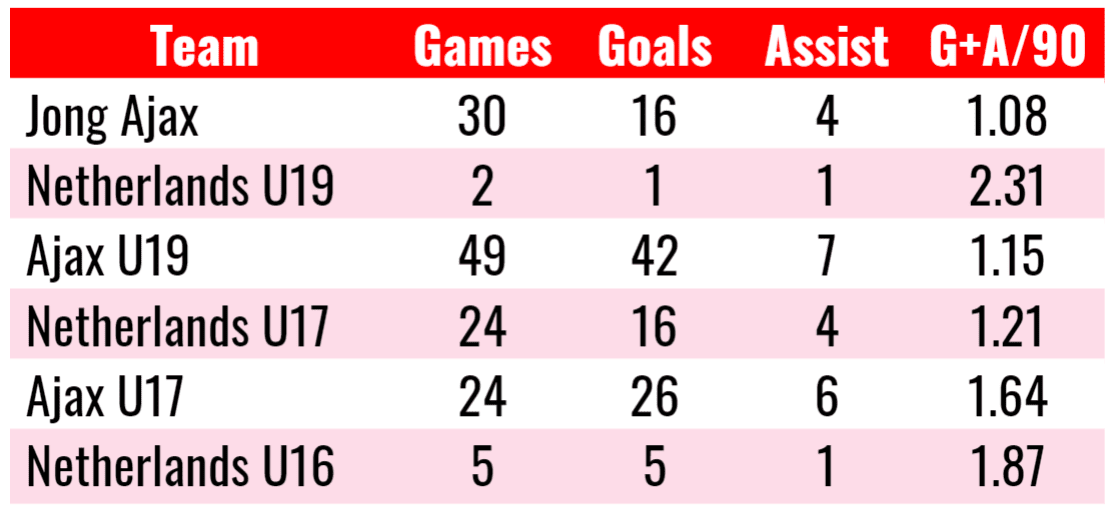
In this tactical analysis, we’ll provide both a data analysis and a scout report to assess Brobbey’s main strengths and weaknesses, what he will bring to his new team’s tactics and in which aspects he could improve in the future.
Data analysis
In the first part of this analysis, we’ll look at some key metrics that will help us understand which aspects Brobbey stands out in. In the three scatter plots we’ve chosen, we’ll see how Brobbey compares to every other striker with at least 400 minutes played in the Eerste Divisie, the Dutch second division, in which he plays with Jong Ajax. We’ve chosen to compare him to the strikers in the second division because he hasn’t played enough minutes in the Eredivisie to take significant conclusions from his data.
Data has been taken from Wyscout and the total population consists of 80 players. The grey parts of the graphs represent the area between the 25th and the 75th percentile for the given metric, so 50% of the players fall in that area, with those falling outside it being really good or really bad in that given metric.
We look at the strikers’ scoring ability in the first graph below. In the x-axis, we have goals per 90 and in the y-axis, xG per 90. Brobbey ranks very highly in both metrics, scoring 0.76 goals per 90 from 0.73 xG. We shouldn’t forget he competes with players of all ages in the Eerste Divisie, so achieving these figures at 19 is even more impressive.
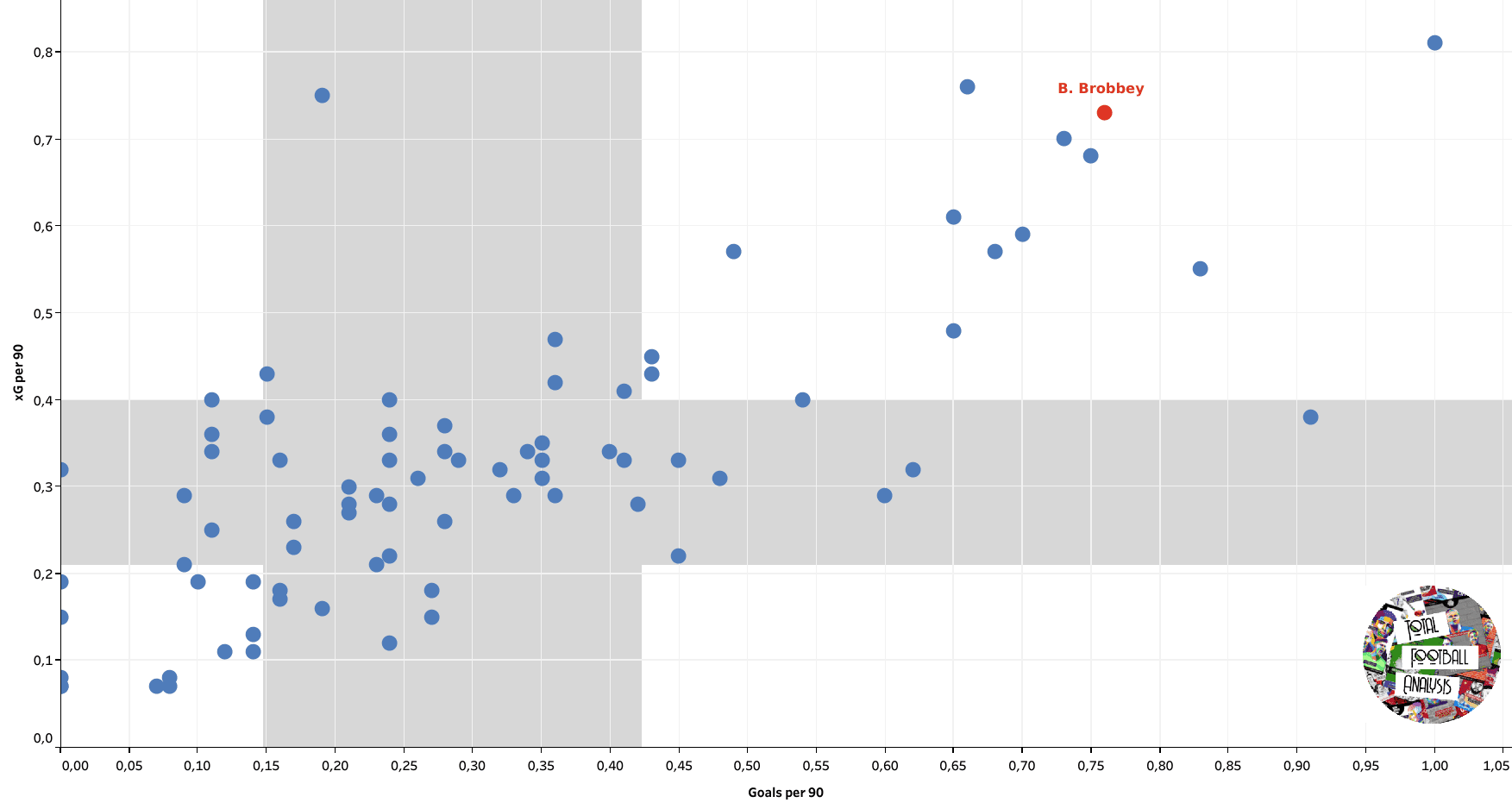
As we’ll see later in this analysis, Brobbey is a striker who excels as the most advanced player of his team and being in charge of finishing the attacks. He’s very active in the box and finds free space to finish his team’s attacks. In the scatter plot below, we see touches in the box per 90 in the y-axis and shots per 90 in the x-axis. Brobbey is the striker with the most touches in the box in the league with 7.49 per 90 and also stands out in shots per 90 with 3.2. We saw in the first graph that he translates this activity in the box into goals and chances.
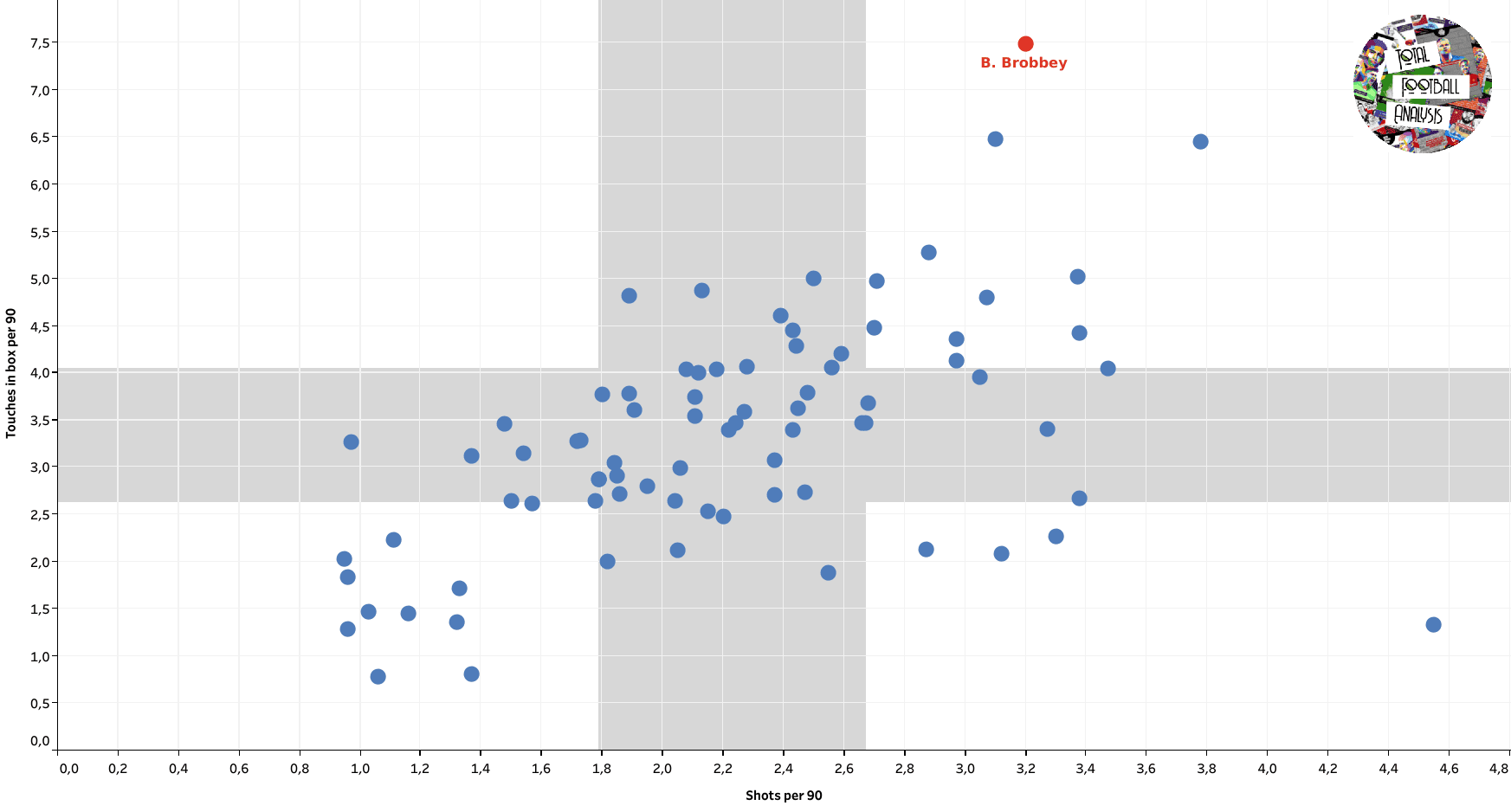
Another distinctive aspect of Brobbey’s playing style is his physicality, which makes him a perfect target for his team’s direct balls, both for him to hold the ball or to run into space. To show this part of his game, we have chosen two metrics: aerial duels won (y-axis) and long balls received (x-axis). Brobbey is in the top 25% in both metrics, winning 60.66% of his aerial duels and receiving 2.69 long passes per 90. This is especially impressive considering he’s not especially tall and that Jong Ajax play a possession-based football that doesn’t rely too much on long balls.
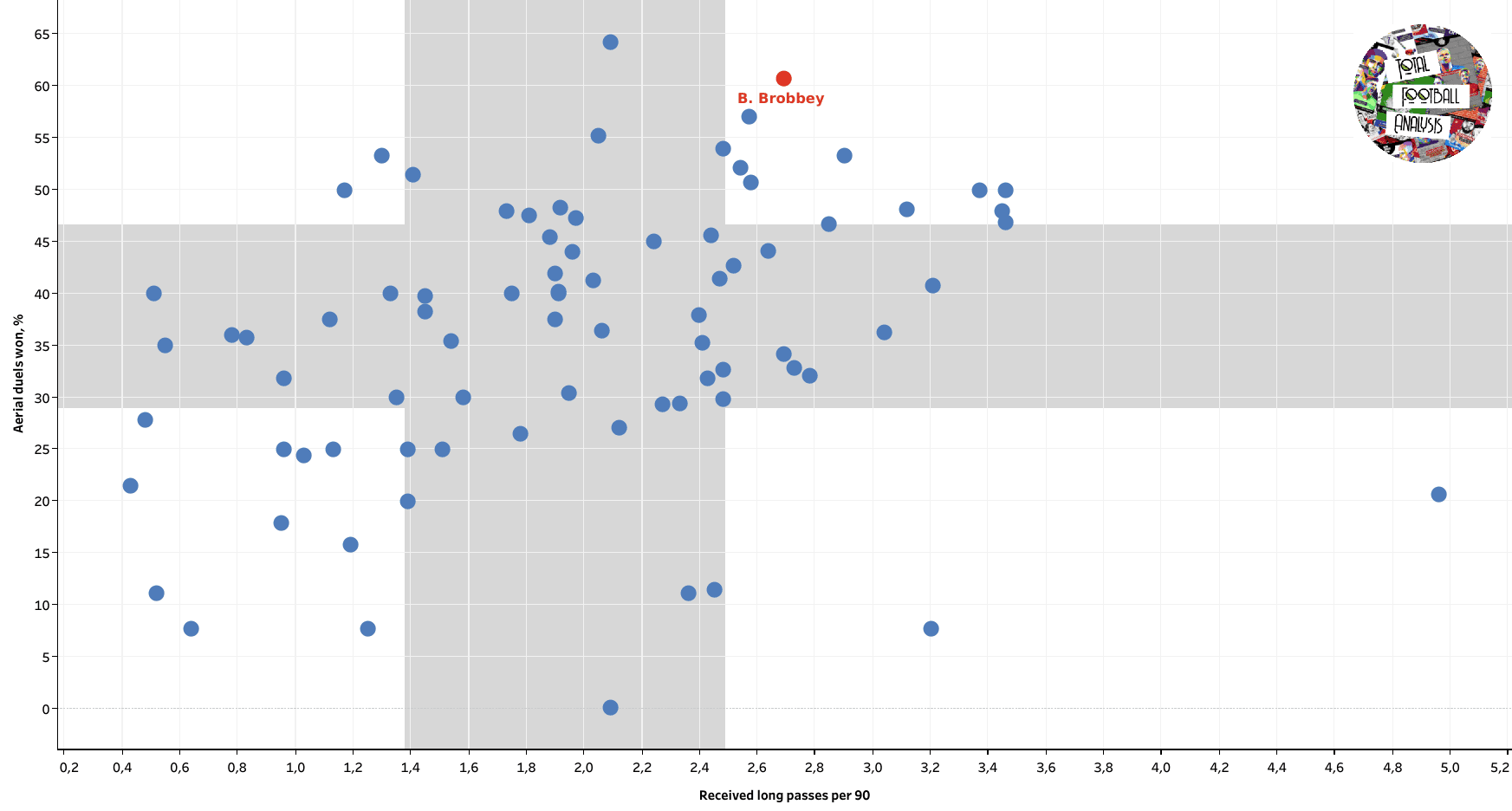
Using Total Football Analysis’ in-house tool xGold to find statistically similar players to Brobbey who play in the Premier League, Bundesliga, Serie A, La Liga or Ligue 1, we find players like Alexander Isak, Romelu Lukaku, Callum Wilson or Moise Kean among the most similar strikers to the Dutch. All of them are powerful strikers capable of playing with their back to the goal or running into space, with a good goalscoring record and solid on the ball.
If we look at Brobbey’s physicality, we see he’s not very tall, standing at 180 cm / 5’11’’. But weighting around 90kg of pure muscle, he’s very big, physical and powerful. He’s been highlighted as the ‘fastest player at Ajax’ and he also ‘jumps higher than Ronaldo’ according to his youth coach and ex EPL and La Liga star Johnny Heitinga. The physical similarity to Romelu Lukaku and Didier Drogba, two of his idols and role models, is obvious even if both of them were quite taller than Brobbey.
In this data analysis that serves as an introduction to a broader tactical analysis, we’ve seen three of Brobbey’s most important attributes. He’s a striker whose main role is finishing the attacks, using his physicality and awareness to get into good positions inside the box. But his physicality can be exploited too with direct balls, using his strength to win aerial duels or hold the ball and his pace to make runs in behind.
Tactical versatility
Brobbey is very complete in the physical aspect as we have seen before in this analysis. Adding a solid technique to that power makes him a very useful player in several tactics. While Ajax and their youth sides stick to the Total Football philosophy, the tactics and formation they use to implement these ideas change quite often.
This season, Brobbey has been used behind the main striker in a 4-2-3-1 formation, as the most advanced player of a 4-3-3 and forming an attacking duo too. In this section of the tactical analysis, we’ll look at how he adapts to different roles and what he can bring to his team’s tactics playing in each of them.
The first thing we must note is that regardless of the tactics he plays in, Brobbey isn’t in contact with the ball too much during the games and his involvement in the attacks isn’t very high. His low number of passes per 90 (22.54, 41st out of 80 strikers) is good evidence of this lack of involvement, especially considering he plays for Jong Ajax, the team with the highest average possession (58.4%) and number of passes per 90 (492.32).
Brobbey’s different roles have something in common: they’re based more on his off-the-ball movements than on his contribution with the ball. He’s intelligent and has the pace to create space, drag defenders out of position and get into good scoring positions with runs in behind or quick movements inside the box. As we have already seen in this scout report, his physicality makes him a perfect option to play long balls to, be it to his feet so he can hold the ball and wait for his teammates or into space to take advantage of his pace.
Regarding his compatibility with other attacking players, he can play behind another striker, usually a big and dominant one who can pin the defenders and win aerial duels like Sébastien Haller, dropping deep to make quick short passes and attacking the box with late runs taking advantage of any spaces created by the main striker.
In the screenshot below, we see Brobbey attacking the box with a late run. The play started with him playing a simple pass in midfield, with the ball being sent to the flanks. Haller makes the run into the box to pin the centre-backs and Brobbey arrives at the box with space in front of him to receive the ball and shoot. His coordination with his striking partner and adaptability to either the running or the target role are key to his overall tactical versatility.
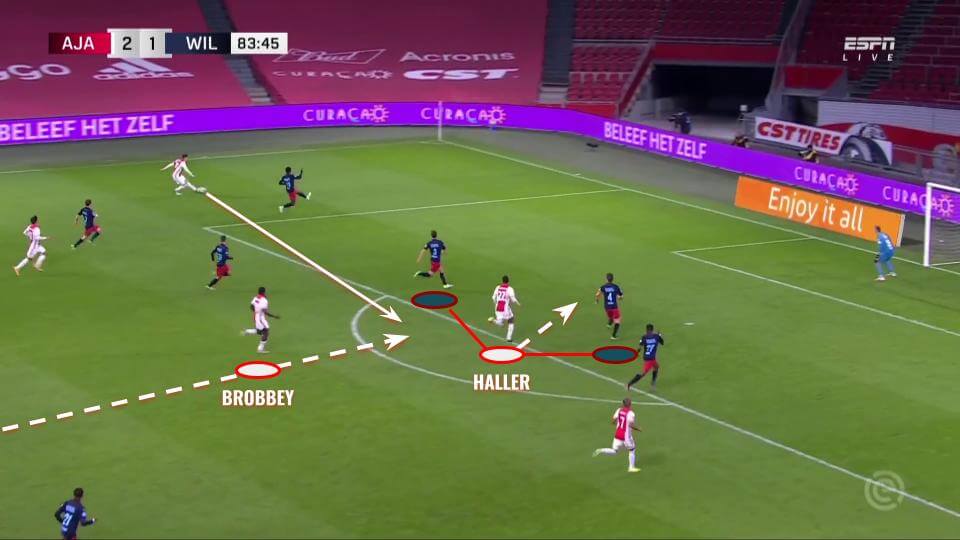
Haller and Brobbey are the protagonists of the play shown below too. This time, a long ball is played to Haller for him to win the aerial duel so Brobey runs in behind him to receive the headed ball. Here, Brobbey is the most advanced player of the duo but he can play both roles comfortably.
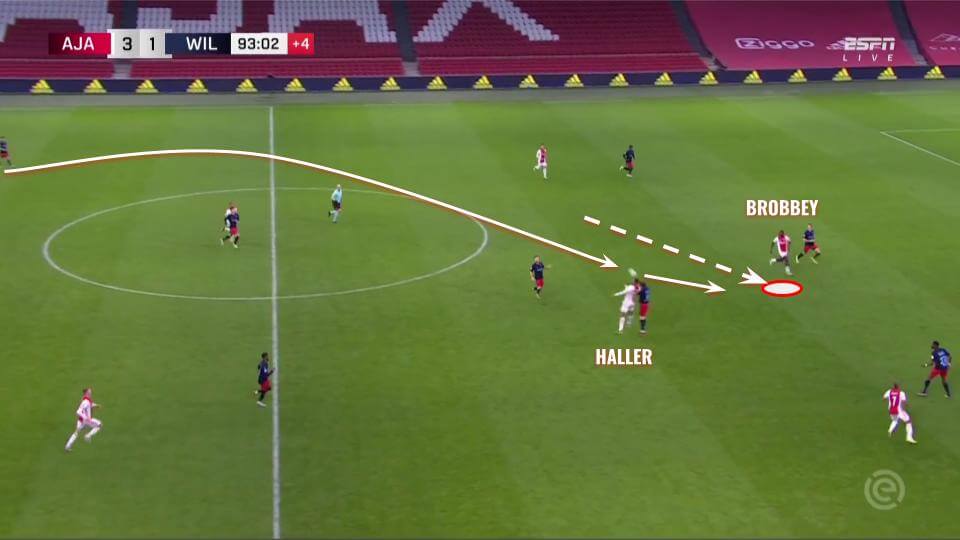
Brobbey is a very good option for direct play too. As we have seen in the first section of this tactical analysis, he’s excellent in the air and if the ball goes over the defensive line he’ll surely get to it thanks to his superior pace. He makes good runs to provide passing options to the defenders in the build-up, not only running towards the goal but also making diagonal movements to the flanks to receive and hold the ball to establish his team in the opposition half.
These same runs apply when Ajax want to initiate quick counter-attacks or establish themselves in the final third quickly. Brobbey will always attack the spaces behind the rival defensive line and either get a chance to score or hold the ball until his teammates arrive, saving his team the work of breaking pressure lines and progressing into the opposition half.
Measuring these runs in behind isn’t possible with event data but offsides per 90 are a good proxy as a player is more likely to be caught offside if he attempts to run in behind more often. Brobbey is the 12th player with the most offside per 90 in the Eerste Divisie this season with 0.87 so the available data supports what we’ve stated in this scout report about his movements to attack the spaces behind the defensive line.
Let’s see an example of his ability to run in behind and provide direct passing options behind the rival defensive line. In the instant seen below, Jong Ajax have just recovered the ball and after two quick passes, they look to start a counterattack. Brobbey, being the only player in the opposition half, starts his run with a disadvantage of a couple of meters with the rival centre-backs but his teammate knows about his pace and plays the pass over the defensive line anyway.
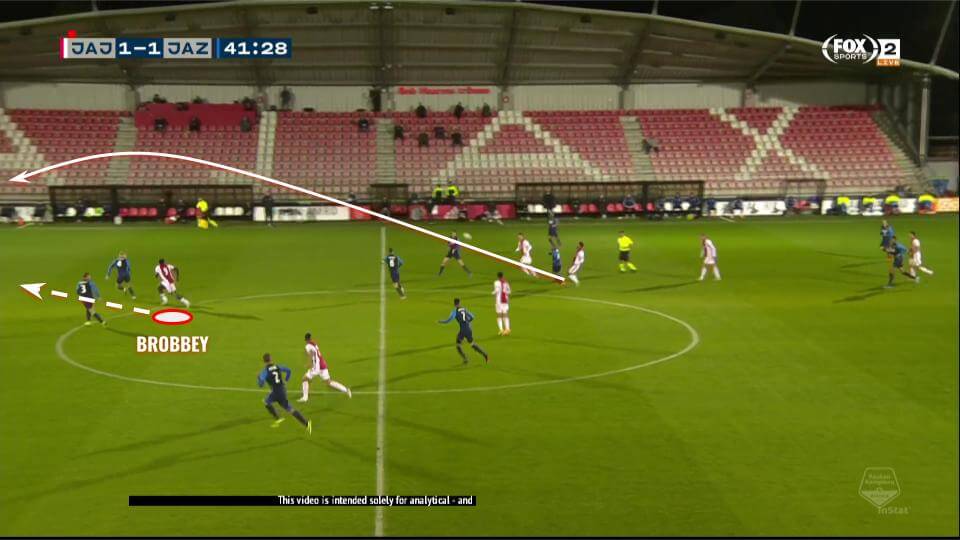
Below, we see the end of the play. Brobbey has already gained an advantage over the central defender thanks to his speed and is using his big and muscular frame to protect the ball while it bounces. He just takes a touch with his lap to drive the ball into the box and finishes with a low shot. It’s also worth noting how the goalkeeper is out of position. The rival shot-stopper may have thought he could get to the ball before Brobbey but was surprised by his pace and needs to rush back to his position between the posts. Running backwards prevents him from reacting as quickly as he could to Brobbey’s shot, which goes between his legs and into the goal.
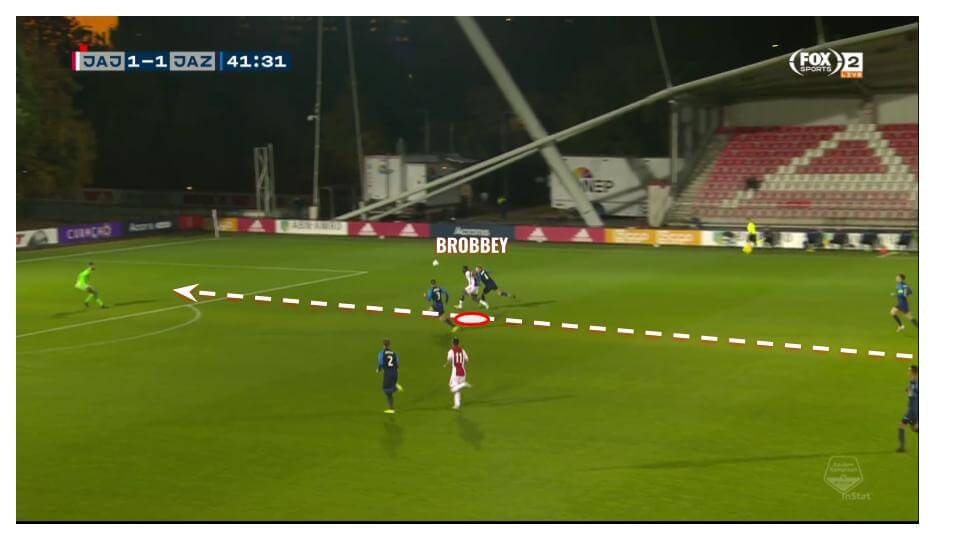
In this section of the scout report, we have seen how Brobbey is useful both as the most advanced option of his team with runs in behind but also as a supporting striker who can play around a target man and use his explosiveness to beat defenders. In the next section, we’ll explore further his movements also in positional attacks.
Movements in the final third
When Ajax are in a positional attack, Brobbey is always looking for space to exploit his explosive pace. He doesn’t need a lot of distance to reach his full speed so he can penalize any positioning mistakes from his rivals in tight spaces. His physical superiority also means he doesn’t need to be close to an offside position to get an advantage. Even when he gives the defender a couple of yards of advantage, he still reaches the ball faster. This pace also means the passes he receives don’t have to be as accurate as for other players because he can reach those that are slightly overhit too.
When teams sit in a low block, which is something Ajax usually face, Brobbey doesn’t lose his effectiveness. As soon as his team’s quick passing combinations move defenders and create holes in the rival defensive structure, Brobbey reacts quickly to cash in those mistakes and get into scoring positions using his velocity.
In the example below, the rival defensive line has lost its shape as a result of Ajax playing quickly the ball from right to left. Brobbey is initially in a position to receive the ball to his feet but as soon as one of the defenders steps out to try to anticipate this pass, he starts a run in behind. There are at least three rivals plus the goalkeeper (marked with blue arrows) who could contest for the ball in behind but Brobbey beats them with his pace. The deep pass isn’t perfect and the goalkeeper rushes out thinking he can get it but he’s surprised by Brobbey’s speed. The striker gets to the ball just before the goalkeeper and suffers a penalty.
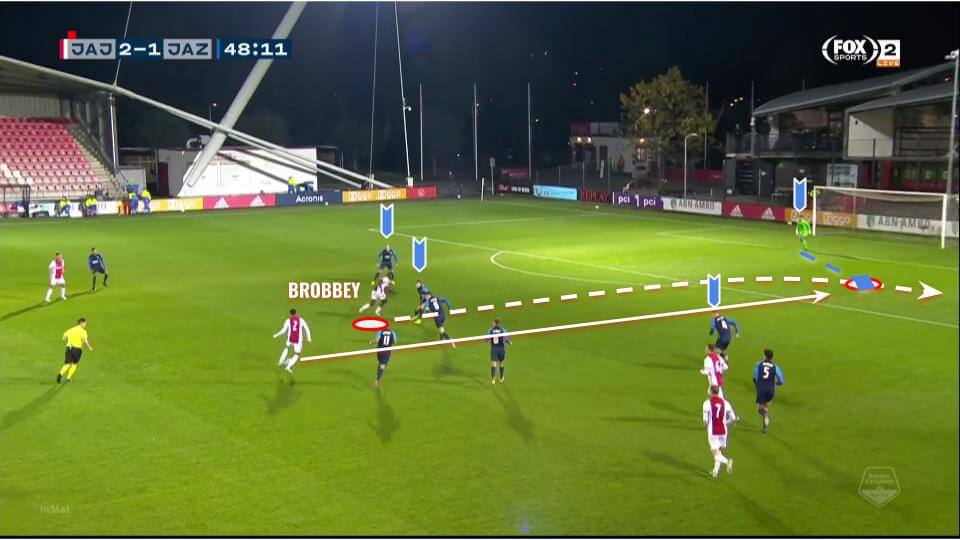
Brobbey’s ability to read the plays and anticipate what’s going to happen doesn’t only apply to those situations in which he’s the direct receiver of the pass. He’s usually a step ahead of the play and initiates his movements early to get into good positions and defend those positions with his physicality. He’s intelligent to understand where the ball may end up in a given play and tries to get there quicker than the rivals to get “easy” goals.
In the play below, a good pass is played over the defensive line to his teammate. !hen the ball is still in the air, Brobbey is already making a run to leave the defender behind and get where he thinks the next pass will be aimed to. His teammate plays a relatively simple first-touch pass and Brobbey scores the tap in.
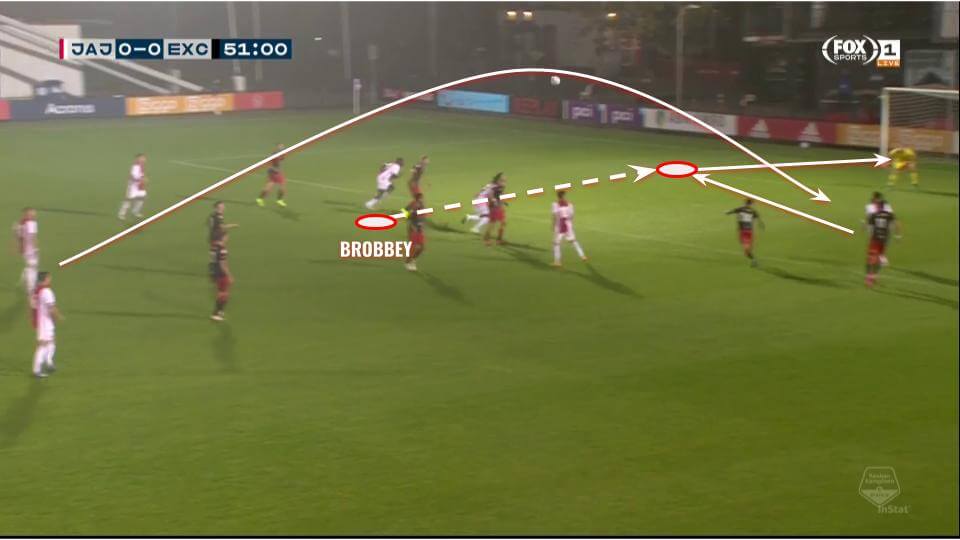
When rivals sit even deeper and there’s no space to run in behind, Brobbey changes the way he uses his physicality to get chances and shots. He looks to receive with his back to the goal and use his strength and power to push defenders back and create a yard to turn and shoot. He resembles Lukaku in this too, using his body to move the defenders and preventing them from intervening.
This can be seen in the next picture. The defensive line is sitting at the edge of the box but Brobbey uses his body to prevent one of the centre-backs from advancing and forming the line with his teammates. When the ball is played to his feet, he controls it with the outside of his right foot, puts his body between the defender and the ball so he can’t intervene and shoots with his left. A lot of power, agility and ability to use the body are required to make this move, apart from a solid technique to control with the right foot and shoot with the left with a defender fighting to get to the ball.
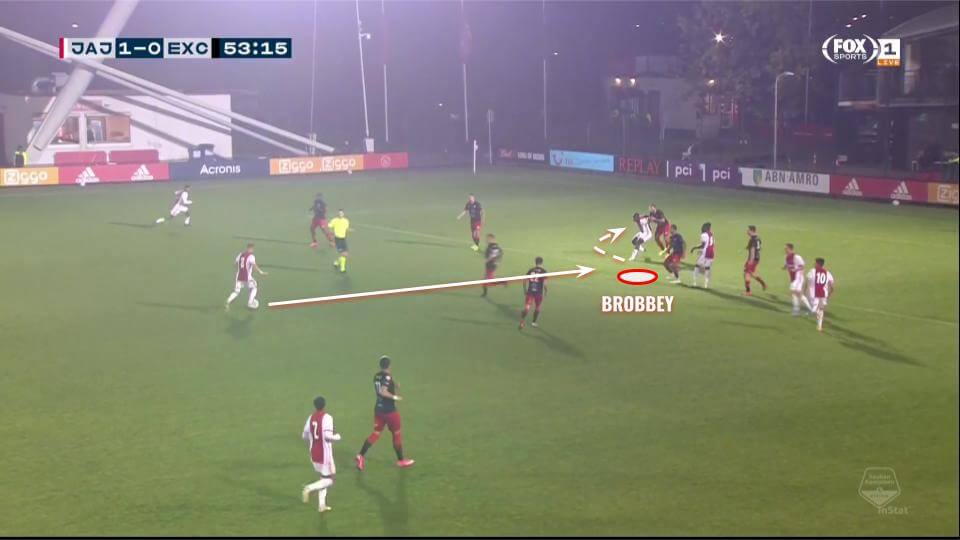
In this section of the scout report, we have seen how Brobbey runs in behind to give passing options to his more creative teammates, how he moves inside the box to be one step ahead of the defenders and how he can create options for himself using his strength while playing with his back to the goal.
Dribbling and finishing
The last part of this analysis will be focused on how Brobbey executes all the actions we’ve described, this is, on his technique. Coming through the academy at Ajax has ensured Brobbey has enough technical ability to control, pass and combine in tight spaces.
Brobbey’s solid technique allows him to receive with his back to the goal and open the ball to the wings before making powerful runs into the box. His passes are quite simple but intelligent and not always the obvious ones to the closest teammates.
Dribbling isn’t his strength. He’s deadly with spaces in front of him because of his power and strength to resist challenges but in tight spaces and can also win a yard to shoot but he isn’t as skilled. Better when he moves off the ball or using quick passes.
He makes good decisions to assist when he’s inside the box, spotting the free teammate and not being selfish. His 0.15 xA per 90 are a nice addition to his scoring contribution. His passing ability comes more from quick and solid decision-making than from his excellent vision or technical ability. When his deep passes to assist his teammates need to be very accurate he doesn’t have the quality to make them and often puts the wrong weight into them, so we shouldn’t expect him to adapt to playing in more creative roles.
More or less the same applies to Brobbey’s dribbling. He can use his pace and power to get past players when playing with spaces in front of him and also create the separation he needs to shoot with sharp movements but he’s not skilled enough to dribble in tight spaces. As we have seen in previous examples, Brobbey uses his body well to protect the ball and turn and he has enough technique to perform these actions quickly and accurately.
When he receives the ball and there’s space between the defensive line and the goal, Brobbey’s power to turn and his pace are very difficult to match. He just needs to push the ball forward and his speed will do the rest. Defenders find it very difficult to stop him and try to foul him to prevent him from starting a run as proven by the 1.35 fouls he suffers per 90.
In the example below, Brobbey is holding the ball but turns quickly and uses his power to get past his man. The defender tries to grab his shirt but he can’t stop Brobbey, who runs to the endline and puts a cross in the box. This dribble doesn’t require much technique but is equally effective.
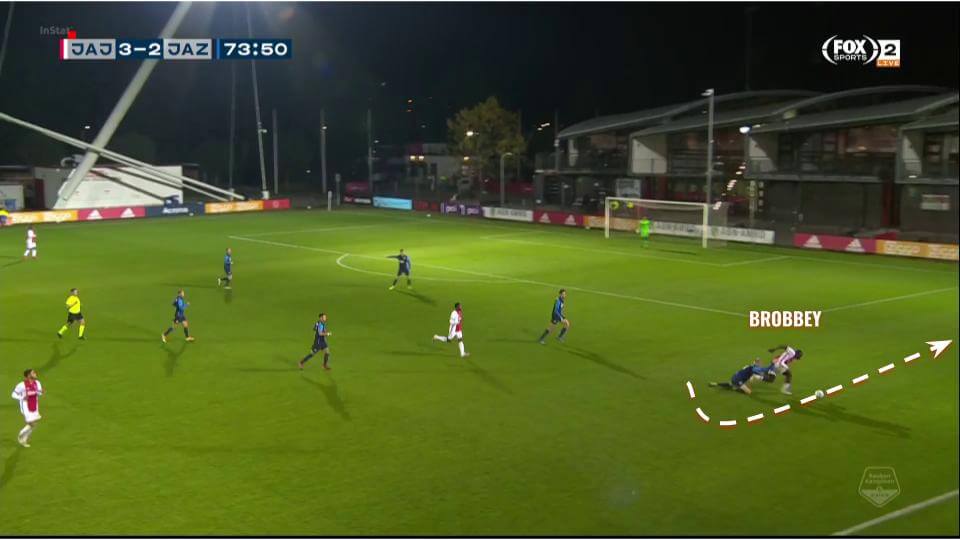
Brobbey’s dribbling stats aren’t too impressive but aren’t bad either. He attempts 4.12 dribbles per 90 (33rd out of 80 strikers in the Eerste Divisie) and completes 44.9% of them (54th). These decent figures prove he usually makes good decisions regarding when and where to dribble and doesn’t overcomplicate things when he knows he doesn’t have the skill to be successful.
Below, we see a play that is counted as a dribble and illustrates well Brobbey’s abilities. He takes the ball at the corner of the box, dribbles to his left using his acceleration to create enough separation and shoots with his left foot. While this dribble doesn’t really eliminate the rival from the play, it does create the situation he needs to finish.
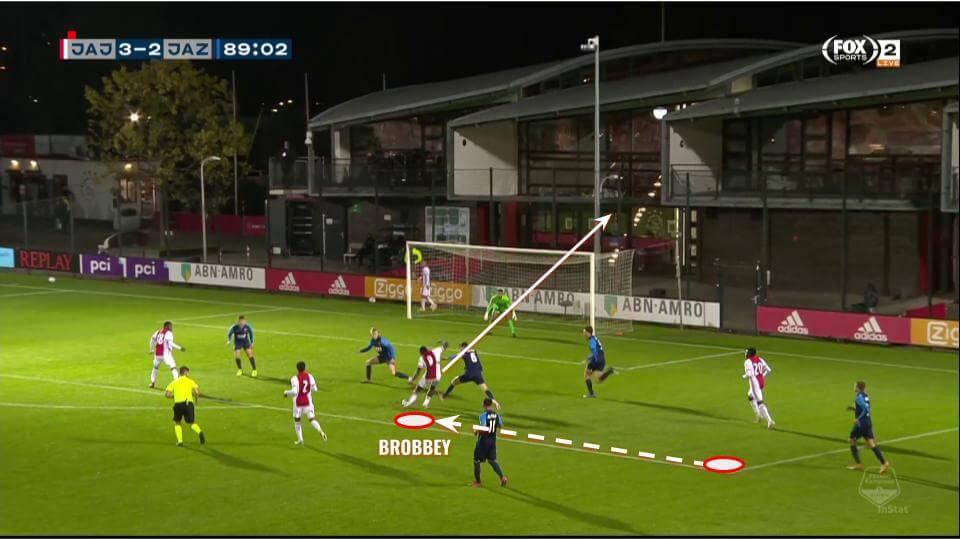
Brobbey’s goals come mostly from poaching around the six-yard box and one-on-one situations against the goalkeeper after a good run in behind so it isn’t surprising that he has a high goal conversion (23.68%, 11th) and shots on target percentage (52.63%, 13th). He doesn’t take many speculative shots from distance or difficult angles, leading to his 0.23 xG/shot, the fifth highest in the league.
This ability to get good chances means Brobbey’s finishing ability isn’t crucial for him to score. In fact, Brobbey is a good finisher but not an excellent one. If we take all the available data, we can see he has scored 30 goals from 28.59 xG, which is good but not mind-blowing. He can finish with both feet with good power but usually tries low shots and his goals rarely come from low xG shots. Sometimes his last touch before shooting isn’t perfect and he gets too close to the goalkeeper or too wide, which also hampers his chances of scoring.
Comfortable finishing with both feet. Once inside the box, he can dribble to the left or the right to create the yard he needs to shoot. He mostly shoots from central areas around the 6-yard box (0.23 xG/shot, 5th highest in the league). This shows his ability to create and find spaces inside the box with sharp movements and using his body to win and protect his position.
Below we see Brobbey’s open-play shot map from this season to support the analysis. We can see the vast majority of his goals come from central positions between the penalty spot and the six-yard box, he almost doesn’t take shots from outside the box and he prefers to shoot with his right foot from the left side of the box, with those shots being on target more often than those taken from the right side of the box.
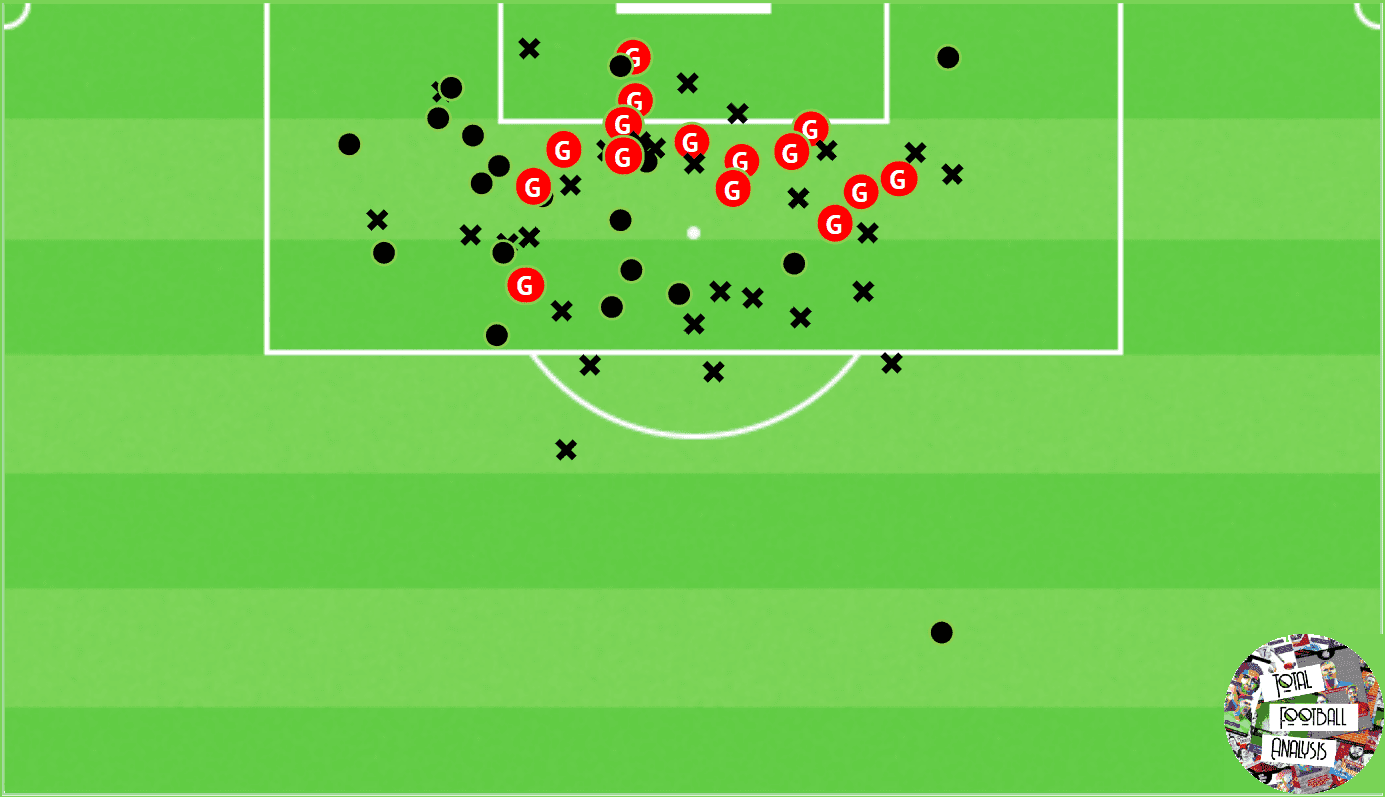
As a summary, we could define Brobbey as a goalscorer who relies on his intelligence and on his pace to get to the correct positions before the rivals. He doesn’t need to be a virtuoso to create chances and his technique is solid to support his superior physicality. We shouldn’t forget he was born in 2002 and still has plenty of room and time to develop in all aspects.
Conclusion
Brobbey will be one of the most sought-after players next summer. Getting a goalscorer with the physical conditions to dominate in any league at just 19 for free doesn’t happen too often and in these difficult times, clubs will be eager to jump at this opportunity.
RB Leipzig seems to be in the pole position to get the young goalscorer but with teams like Real Madrid, Borussia Dortmund, AC Milan or Manchester United also interested, the new Mino Raiola’s star will have plenty of options to make a decision. What seems clear is that the club that gets him will get a dominant player for the next decade and an asset that will surely increase its value season after season.





Comments